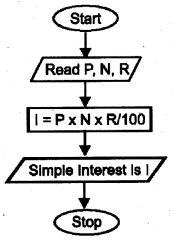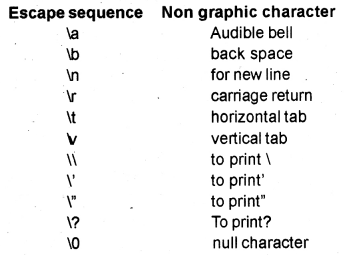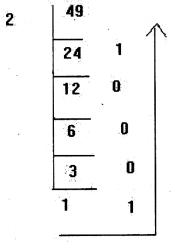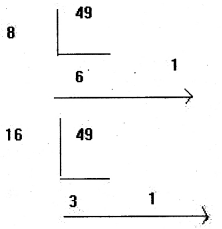Kerala Plus One Computer Science Model Question Paper 1 with Answers
| Board | SCERT |
| Class | Plus One |
| Subject | Computer Science |
| Category | Plus One Previous Year Question Papers |
Time Allowed: 2 hours
Cool off time: 15 Minutes
Maximum Marks: 60
General Instructions to Candidates:
- There is a ‘cool off time’ of 15 minutes in addition to the writing time of 2 hours.
- Use the ‘cool off time’ to get familiar with the questions and to plan your answers.
- Read questions carefully before you answering.
- Read the instructions carefully.
- Calculations, figures, and graphs should be shown in the answer sheet itself.
- Malayalam version of the questions is also provided.
- Give equations wherever necessary.
- Electronic devices except non-programmable calculators are not allowed in the Examination Hall.
Answer all questions from question numbers 1 to 5. Each carry one score. (5 × 1 = 5)
Question 1.
Which data type of C++ does not require any memory space?
Answer:
Void
Question 2.
Who is regarded as the father of modern Computer Science as well as artificial intelligence?
Answer:
Alan Turing
Question 3.
In C++, …….. loop will execute at least once even though the condition is false.
Answer:
do while loop
Question 4.
In C++, ………… function is used to input a character or string using cin
Answer:
cin.getline(variable, size)
Question 5.
Expand URL
Answer:
Uniform Resource Locator
Answer any 9 (nine) questions from 6 to 16. Each carries 2 score. (9 × 2 = 18)
Question 6.
What are the advantages of second generation computers over first generation computers?
Answer:
First generation (1 G) computer was based on analog system and only voice transmission was allowed. Second generation(2 G) is the next generation network that was allowed voice and data transmission. Picture message and MMS(Multimedia Messaging Service) were introduced. GSM and CDMA standards were introduced by 2G.
Question 7.
Find the dual of following boolean equations.
a) X + \(\bar{X}\) = 1
b) (X + 0).(X. 1. \(\bar{X}\)) = 0
Answer:
a) \(\overline{\mathrm{X}}\).X = 0
b) (\(\overline{\mathrm{X}}\).1) + (\(\overline{\mathrm{X}}\) + 0 + X) = 1
Question 8.
Which are the various e-waste disposal methods?
Answer:
e-Waste disposal methods
- Reuse: Reusability has an important role of e-Waste management and can reduce the volume of e-Waste
- Incineration: It is the process of burning e Waste at high temperature in a chimney
- Recycling of e-Waste: It is the process of making new products from this e-Waste.
- Landfilling: It is used to level pits and cover by thick layer of soil.
Question 9.
Draw the flow chart to find the simple interest.
(Hint: I = P*N*R)
Answer:

Question 10.
Explain any two escape sequences used in C++.
Answer:

Question 11.
List and correct the errors in the following C++ statement:
Cout <“Computer Science”
Answer:
Error 1: The stream object cout must be lower case.
Error 2: Each and every statement must be end with semicolon.
The correct code is as follows
cout<<“Computer Science”;
Question 12.
What are the different ways to write comments in C++?
Answer:
Comments are 2 types single line and multi line comment. For Single line comment \\ is used. The statements after \\ is treated as not a part of the program in a line.
Multi line comment starts with /* and ends with */. We can make multiple lines as comment.
Question 13.
Write a brief explanation for the below mentioned C++ statement:
int a [ ]= {2, 3, 5, 6, 9};
Answer:
int a[ ] = {2, 3, 5, 6, 9};
Here a is an integer array with 5 elements. The operating system allocates 4*5=20 Bytes of memory. Only the sufficient amount of memory is allocated hence no wastage of memory is in this type of declaration.
The first element is a[0] = 2
The second element is a[1] = 3 and so on.
Question 14.
Explain the memory allocation for strings.
Answer:
Memory allocation for strings: To store “BVM” an array of char type is used. We have to specify the size. Remember each and every string is end with a null (\0) character. So we can store only size-1 characters in a variable. Please note that \0 is treated as a single character. \0 is also called as the delimiter.
char school_name[4]; By this we can store a maximum of three characters.
Question 15.
Differentiate global and local variables.
Answer:
| Local Variable | Global Variable |
| 1. Declared inside a block | 1. Declared outside of all blocks |
| 2. It cannot be used any other block | 2. It can be used anywhere in the program |
| 3. Memory is allocated when the block is active | 3. Memory is allocated when the program begins |
| 4. Memory is deallocated when the block is completed | 4. Memory is deallocated when the program terminates |
Question 16.
What are the hardware and software requirements for connecting a computer to internet?
Answer:
The hardware and software requirement for internet.
- A computer with a modem (internal/external)
- A telephone connection
- An account with an ISP
- A browser S/W eg: Internet Explorer or Mozilla…
Answer any 9 (nine) questions from 17 to 27. Each carries 3 score. (9 × 3 = 27)
Question 17.
Fill in the blanks
(49)10 = (……..)2 = (……..)8 = (………)16
Answer:


(49)10 = (110001)2 = (61)8 = (31)16
Question 18.
a) Write an algorithm to print the even numbers between 1 and 100. (2)
b) Write any one advantage of using the flow chart. (1)
Answer:
a) Algorithm
Step 1: Start
Step 2: Set i=1;
Step 3: if i>100 goto Step 6.
Step 4: Print i;
Step 5: i=i+1 goto Step 3.
Step 6: Stop
b) Advantages of Flowcharts are Better Communication Effective analysis Effective synthesis Efficient coding.
Question 19.
Explain different components of CPU.
Answer:
Processors:
It is the brain of the computer and consists of three components
- Arithmetic Logic Unit(ALU)- As the name implies it performs all calculations and comparison operations.
- Control Unit(CU) – It controls over all functions of a computer
- Registers – It stores the intermediate results temporarily.
A CPU is an Integrated Circuit(IC) package contains millions of transistors and other components.
Popular Processors are Intel core i3, core i5, core i7, AMD Quadcore etc.
Question 20.
Which are the different universal gates? Why they are called so? Draw the logical symbols of these gates.
Answer:
Universal gates:
By using NAND and NOR gates only we can create other gates hence these gates are called Universal gate.
1. NAND gate
The output of AND gate is inverted by NOT gate is the NAND gate
In short the NAND gate is as shown below

2. NOR gate
The output of OR gate is inverted by NOT gate is the NOR gate.
In short the NOR gate is shown below

Question 21.
Describe the different phases in programming.
Answer:
Phases in Programming
1. Problem identification: This is the first phase in programming. The problem must be identified then only it can be solved, for this we may have to answer some questions.
2. Deriving the steps to obtain the solution.
There are two methods, Algorithm and flowchart, are used for this.
a) Algorithm The step-by-step procedure to solve a problem is known as algorithm. It comes from the name of a famous Arab mathematician Abu Jafer Mohammed Ibn Musaa Al-Khowarizmi, The last part of his name Al-Khowarizmi was corrected to algorithm.
b) Flow chart:- The pictorial or graphical representation of an algorithm is called flow chart.
3. Coding:- The dummy codes (algorithm) or flow chart is converted into program by using a computer language such s Cobol, Pascal, C++, VB, Java,……..etc.
4. Translation:- The computer only knows machine language. It does not know HLL, but the human beings HLL is very easy to write programs. Therefore a translation is needed to convert a program written in HLL into machine code (object code). During this step, the syntax errors of the program will be displayed. These errors are to be corrected and this process will be continued till we get “No errors” message. Then it is ready for execution.
5. Debugging The program errors are called ‘bugs’ and the process of detecting and correcting errors is called debugging. In general there are two types of errors syntax errors and logical errors. When the rules or syntax of the language are not followed then syntax errors occurred and it is displayed after compilation. When the logic of a program is wrong then logical errors occurred and it is not displayed after compilation but it is displayed in the execution and testing phase.
6. Execution and Testing:- In this phase the program will be executed and give test data for testing the purpose of this is to determine whether the result produced by the program is correct or not. There is a chance of another type of error, Run time error, this may be due to inappropriate data.
7. Documentation:- It is the last phase in programming. A computerized system must be documented properly and it is an ongoing process that starts in the first phase and continues till its implementation. It is helpful for the modification of the program later.
Question 22.
What will be the output of the following C++ program?
#include<iostream>
using namespace std;
int main ()
{
int a, b, c;
a = 5;
b = 8;
c = a;
cout<<“\n Value of a is”<<++a;
cout<<“\n Value of b is”<<b++;
cout<<“\n Value of c is”<<–c;
return 0;
}
Answer:
Value of a is 6
Value of b is 8
Value of c is 5
Question 23.
Differentiate if…else if and switch statements in C++.
Answer:
Following are the difference between switch and if else if ladder.
- Switch can test only for equality but if can evaluate a relational or logical expression
- If else is more versatile
- If else can handle floating values but switch cannot
- If the test expression contains more variable if else is used
- Testing a value against a set of constants switch is more efficient than if else
Question 24.
Explain any three array operations.
Answer:
Array operations:
- Traversal – Accessing all the elements of an array is called traversal.
- Sorting – Arranging elements of an array in an order(ascending or descending)
Eg: Bubble sort and Selection sort - Searching – It is the process of finding the position of the given element.
Linear search and Binary search are the operations
Question 25.
Write C++ statements to declare a two-dimensional array of integers having 3 rows and 2 columns and input values to it.
Answer:
#include<iostream>
using namespace std;
int main()
{
int i,j,n[3][2];
cout<<“Enter 6 elements:”;
for(i=0;i<3;i++)
for(j=0;j<2;j++)
cin>>n[i][j];
cout<<“The elements are given below\n”;
for(i=0;i<3;i++)
{
for(j=0;j<2;j++)
cout<<n[i][j]<<“\t”;
cout<<“\n”;
}
}
Question 26.
Explain about any three string functions in the header file cstring.
Answer:
String functions
To manipulate string in C++ a header file called cstring must be included.
a. strlen()- to find the number of characters in a string(i.e. string length).
Syntax: strlen(string);
Eg. cout<<strlen(“Computer”); It prints 8.
b. strcpy()- It is used to copy second string into first string.
Syntax: strcpy(string1, string2);
Eg. strcpy(str,”BVM HSS”);
cout<<str; It prints BVM HSS.
c. strcat()- It is used to concatenate second string into first one.
Syntax: strcat(string1 ,string2)
Eg. strcpy(str1,’’Hello”);
strcpy(str2,” World”);
strcat(str1,str2);
cout<<str1; It displays the concatenated string “Hello World”
Question 27.
Differentiate Call-by-Value and Call-by-Reference methods in function calls.
Answer:
| Call by Value | Call by Reference |
| 1. Ordinary variables are used as formal parameter | 1. Reference variables are used as formal parameters |
| 2. A copy of the original value is passed | 2. The original value is passed |
| 3. Any change made by the function will not affect the original value | 3. Any change made by the function will affect the original value |
| 4. Separate memory location is needed for actual and formal variables | 4. Memory of actual arguments is shared by formal arguments. |
Answer any 2 (two) questions from 28 to 30. Each carries 5 scores. (2 × 5 = 10)
Question 28.
a) What is network topology? (1)
b) Which are the different types of network topologies? (1)
c) Explain any two network topologies. (3)
Answer:
a) Network topologies: Physical or logical arrangement of computers on a network is called structure or topology. It is the geometrical arrangement of computers in a network.
b) The major topologies developed are star, bus, ring, tree and mesh.
c) (Any two from the following)
1) Star Topology: A star topology has a server all other computers are connected to it. If computer A wants to transmit a message to computer B. Then computer A first transmit the message to the server then the server retransmits the message to the computer B. That means all the messages are transmitted through the server. Advantages are add or remove workstations to a star network is easy and the failure of a workstation will not effect the other. The disadvantage is that if the server fails the entire network will fail.
2) Bus Topology: Here all the computers are attached to a single cable called bus. Here one computer transmits all other computers listen. Therefore it is called broadcast bus. The transmission from any station will travel in both the direction. The connected computers can hear the message and check whether it is for them or not.
Advantages are add or remove computer is very easy. It requires less cable length and the installation cost is less. Disadvantage is fault detection is very difficult because of no central computer.
3) Ring Topology: Here all the computers are connected in the shape of a ring and it is a closed loop. Here also there is no central computer. Here a computer transmits a message, which is tagged along with its destination computer’s address. The message travels in one direction and each node check whether the message is for them. If not, it passes to the next node.
It requires only short cable length. If a single node fails, at least a portion of the network will fail. To add a node is very difficult.
4) Hybrid Topology: It is a combination of any two or more topologies. Tree topology and mesh topology can be considered as hybrid topology.
a) Tree Topology: The structure of a tree topology is the shape of an inverted tree with a central node and branches as nodes. It is a variation of bus topology. The data transmission takes place in the way as in bus topology. The disadvantage is that if one node fails, the entire portion will fail.
b) Mesh Topology: In this topology each node is connected to more than one node. It is just like a mesh (net). There are multiple paths between computers. If one path fails, we can transmit data through another path.
Question 29.
Explain about any five input or output devices used in computer.
Answer:
Input devices: It is used to supply data to the computer for processing
1) Key board: It is the most widely used device to input information in the form of words, numbers etc. There are 101 keys on a standard key board. The keys on the key board are often classified into alpha numeric keys (A to Z, 0 to 9), function keys (F1 to F12), special purpose keys (Special characters), cursor movement keys (arrow keys). While pressing a key, the corresponding code’s signal is transmitted to the computer.
2) Mouse: It is a pointing device, that controls the movement of the cursor, or pointer as a display screen. A mouse has two or three buttons, it is often used in GUI oriented computers. Underthe mouse there is a ball, when the mouse moves on a flat surface this ball also moves. This mechanical motion is converted into digital values that represents x and y values of the mouse movement.
3) Light Pen: It is an input device that use a light sensitive detector to select objects directly on a display screen using a pen. Light pen has a photocell placed in a small tube. By using light pen, we can locate the exact position on the screen.
4) Touch screen: It allows the user to enter data by simply touching on the display screen. This technology is applied in tablets, cell phones, computers etc.
5) Graphic tablet: It consists of an electronic writing area. We can create graphical images by using a special pen.
OR
Output devices: After the data processing the result is displayed as soft copy(soft copy can. view, only by using a device) or hard copy(lt can read easily).
1) Visual Display Unit
a) Cathode Ray Tube (CRT): There are two types of CRT’s, monochrome (Black and white) and colour. Monochrome CRT consists of one electron gun but colour CRT consists of 3 electron guns (Red, Green and Blue) at one end and the other end coated with phosphor. It is a vacuum tube. The phosphor coated screen can glow when electron beams produced by electron guns hit. It is possible to create all the colours using Red, Green and Blue. The images produced by this is refreshed at the rate of 50 or 60 times each second. Its disadvantage is it is heavy and bulky. It consumes more power and emits heat. But it is cheap. Nowadays its production is stopped by the company.
b) Liquid Crystal Display (LCD): It consists of two electrically conducting plates filled with liquid crystal. The front plate has transparent electrodes and the back plate is a mirror. By applying proper electrical signals across the plates, the liquid crystals either transmit or block the light and then reflecting it back from the mirror to the viewer and hence produce images. It is used in where small sized displays are required.
c) Light Emitting Diode(LED): It uses LED behind the liquid crystals in order to light up the screen. It gives a better quality and clear image with wider viewing angle. Its power consumption is less.
d) Plasma Panels: It consists of two glass plates filled with neon gas. Each plate has several parallel electrodes, right angles to each other. When low voltage is applied between two electrodes, one on each plate, a small portion of gas Is glow and hence produce images. Plasma displays provide high resolution but are expensive. It is used in, where quality and size is a matter of concern.
e) Organic Light Emitting Diode(OLED) Monitors: It is made up of millions of tiny LEDs. OLED monitors are thinner and lighter than LCDs and LEDs. It consumes less power and produce better quality images but it is very expensive.
LCD projector: It is used to display video, images or data from a computer on a large screen. Its main component is a high intensity light producing bulb and a lens.
2) Printer: There are two types of printers impact and non impact printers. Printers are used to produce hard copy.
Impact Printers: There is a mechanical contact between print head and the paper.
i) Dot Matrix Printer: Here characters are formed by using dots. The printing head contains a vertical array of pins. The letters are formed by using 5 dot rows and 7 dot columns. Such a pattern is called 5×7 matrix. This head moves across the paper, the selected pins fire against an inked ribbon to form characters by dot. They are capable of faster printing, but their quality is not good.
Non-impact Printers: There is no mechanical contact between print head and paper so carbon copies cannot be possible to take. They are inkjet, laser, thermal printers etc.
a) Inkjet Printer: It works in the same fashion as dot matrix printers, but the dots are formed with tiny droplets of ink to be fired from a bottle through a nozzle. These droplets arc deflected by an electric field using horizontal and vertical deflection plates to form characters and images. It is possible to generate colour output. They produce less noise and produce high quality printing output. The printing cost is higher. Here liquid ink is used.
b) Laser Printer: It uses photocopying technology. Here instead of liquid ink dry ink powder called toner is used. A drum coated with positively charged photoconductive material is scanned by a laser beam. The positive charges that are illuminated by the beam are dissipated. The drum is then rolled through a reservoir of negatively charged toner which is picked up by the charged portions of the drum. It adheres to the positive charges and hence creating a page image on the drum. Monochrome laser printer uses a single toner whereas the colour, laser printer uses four toners. Its print quality is good less noise and printing cost is higher.
c) Thermal Printers: It is same as dot matrix printer but it needs heat sensitive paper. It produces images by pushing electrically heated pins to the special paper. It does not make an impact on the paper so we cannot produce carbon copies. It produce less noise, low quality print and inexpensive. It is used in fax machine.
3) Plotter:
A plotter is a device that draws pictures or diagrams on paper based on commands from a computer. Plotters draw lines using a pen. Pen plotters generally use drum or flatbed paper holders. In a drum plotter the paper is mounted on the surface of a drum. Here the paper is rotated. But in a flatbed plotter the paper does not move and the pen holding mechanism provides the motion that draws pictures. Plotters are used in engineering applications where precision is needed.
4) Three Dimensional (3D) printer: This device is used to print 3D objects.
5) Audio output devices: Speakers are used to produce sound by the backward and forward movement of the diaphragm in the speaker according to the electrical signals from the computer through the audio port.
Question 30.
Write a C++ program to input an integer and check whether it is Armstrong number or not.
(Hint: Amstrong number is the one in which sum of cubes of digits in that number is the number itself.)
eg. 371 = 33 + 73 + 13 = 371
Answer:
#include<iostream>
using namespace std;
intmain()
{
int n,m,rem,cube=0;
cout<<“Enter a number”;
cin>>n;
m=n;
while(n)
{
rem=n%10;
cube=cube+rem*rem*rem;
n=n/10;
}
if(cube==m)
cout<<“The number” <<m<< “is Armstrong”;
else
cout<<“The number” <<m<< “is not Armstrong”;
}
